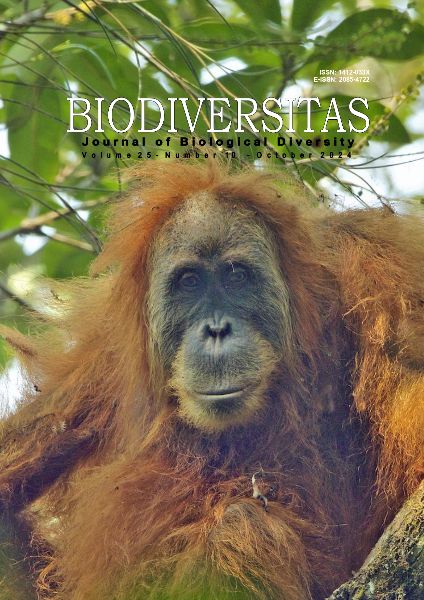Diversity and distribution trends of bats along elevation and habitat gradients in Mount Tuminungan, Bukidnon, Philippines
##plugins.themes.bootstrap3.article.main##
Abstract
Abstract. Lama JMN, Caballero EB, Maceda JN, Omandam JE, Mondejar EP. 2024. Diversity and distribution trends of bats along elevation and habitat gradients in Mount Tuminungan, Bukidnon, Philippines. Biodiversitas 25: 3728-3738. Chiropterans are considered as bioindicators due to their sensitivity to changes in their immediate environment. With climate change threats getting more severe, data on how elevation and different habitats affect bat diversity is very important in predicting and monitoring the probable upslope relocation of bat species. Hence, this study aims to examine the species diversity of bats at various elevations and habitat gradients in the Daraghuyan ancestral domain at Sitio Damitan in Barangay Dalwangan, Malaybalay City, Bukidnon, Philippines. Mist netting was used to sample bats in five sampling sites within the area, covering an elevation spectrum from 1525 to 1796 masl and habitat ranging from a mixed agroecosystem (MAE), forest patches within the agroecosystem (FPA), secondary montane forest to mossy forest. This study recorded six species of bats (n=392 individuals), predominantly Pteropodidae, with the additional record of population size, distribution and extent of occurrence of Alionycteris paucidentata Kock 1969 within Mount Kitanglad Range Natural Park (MKRNP). Sampling site 1b (FPA) had the highest relative abundance (33.42%) and bat diversity (H’=1.346) while Site 2, an intact lower montane forest (LMF), had highest species richness (n=5). Canonical Correspondence Analysis (CCA) and GIS mapping showed several variables (i.e., elevation, vegetation, and geographical characteristic) with significant associations with bat occurrence and abundance. This study emphasizes the role of the Daraghuyan ancestral domain as one of the important habitats for bats in Mount Kitanglad Range Natural Park.


 https://orcid.org/0009-0002-5952-3917
https://orcid.org/0009-0002-5952-3917